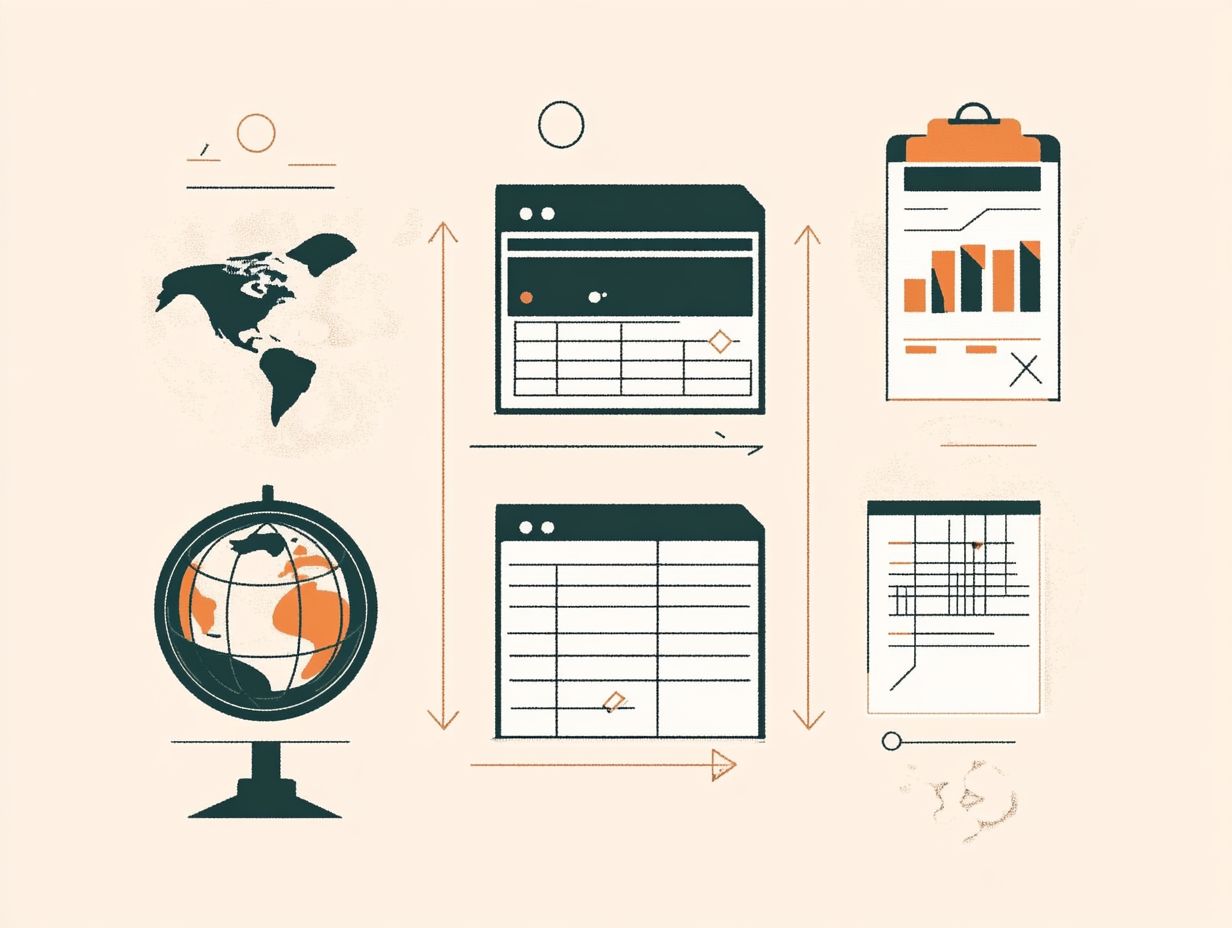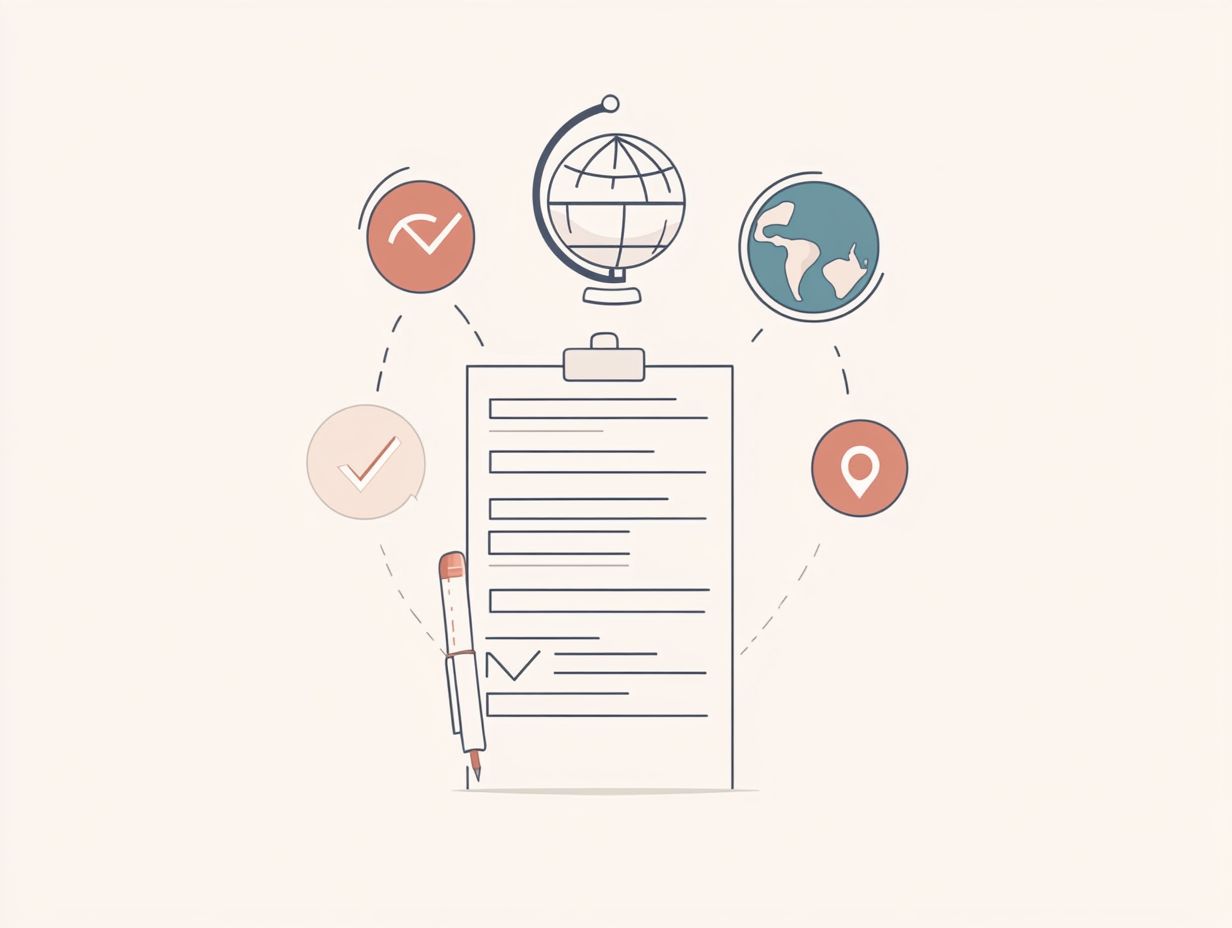5 Steps for Filing an International Patent
Navigating the world of international patents may seem daunting, but it doesn t have to be.
As an inventor, entrepreneur, or business owner, protecting your intellectual property on a global scale is essential. This article outlines five key steps to help you determine if you need an international patent, conduct thorough searches, and file applications with precision.
Throughout this journey, you ll explore the benefits, costs, timelines, and common pitfalls to avoid. This way, you ll be well-equipped for this critical endeavor.
Start now to protect your ideas and unlock global opportunities!
Contents
- Key Takeaways:
- 1. Determine If You Need an International Patent
- 2. Conduct a Thorough Patent Search
- 3. File a Patent Application with Your Home Country’s Patent Office
- 4. File a PCT Application
- 5. File for National Patents in Countries of Interest
- What Are the Benefits of Filing an International Patent?
- What Are the Key Differences Between an International Patent and a National Patent?
- What Are the Costs Associated with Filing an International Patent?
- How Long Does It Take to Obtain an International Patent?
- What Are the Common Mistakes to Avoid When Filing an International Patent?
- What Are the Best Practices for Maintaining an International Patent?
- Frequently Asked Questions
- What is an international patent?
- What are the benefits of filing an international patent?
- What are the 5 steps for filing an international patent?
- Do I need a lawyer to file an international patent?
- How long does it take to file an international patent?
- How much does it cost to file an international patent?
Key Takeaways:

First, determine if you need an international patent for your invention.
Then, conduct a full patent search to ensure your idea is unique and not already patented in other countries.
Finally, file a PCT (Patent Cooperation Treaty) application to obtain a priority date, allowing time to decide on specific countries for national patents. Additionally, consider following the 5 steps to a successful trademark application to protect your intellectual property effectively.
1. Determine If You Need an International Patent
Determining whether you need an international patent is crucial for safeguarding your invention across multiple countries. This ensures your technology and rights are protected in a competitive global landscape, which involves understanding the laws in different countries and the benefits of treaties like the Patent Cooperation Treaty (PCT).
As you consider pursuing an international patent, evaluate the novelty of your invention. This significantly influences its eligibility and strength in various jurisdictions.
It s also important to assess potential markets. Identify where your innovation can thrive and generate revenue.
Legal protections vary from one country to another, making it imperative to understand local regulations to avoid potential pitfalls. The PCT simplifies the application process by allowing a single filing to cover multiple countries, easing the burden for inventors.
Various institutions play a vital role in assisting you on this journey. They offer valuable guidance on patent strategies and help you navigate the intricate legal landscape.
2. Conduct a Thorough Patent Search
Conducting a thorough patent search is vital to determine the novelty of your invention. By identifying prior art and existing patents, you can gain insights that may influence your application process and chances of securing protection.
This step is crucial for your success! By leveraging tools and databases from esteemed organizations like the World Intellectual Property Organization (WIPO) and various national patent offices, you can significantly enhance the effectiveness of your search.
As you navigate these resources, it s crucial to interpret the search results meticulously, paying attention to how previously filed patents relate to your invention.
Patent examiners play a crucial role in this process. They evaluate your claims against the identified prior art, ensuring your application meets the necessary criteria for novelty and non-obviousness.
3. File a Patent Application with Your Home Country’s Patent Office
Filing a patent application with your home country’s patent office is often the first step in securing protection for your invention. To strengthen your application, consider following 5 tips for writing a strong patent application. This process establishes your rights and sets the stage for potential international applications under the PCT or national patents in other countries.
To embark on this crucial journey, gather all required documents, which typically include:
- A detailed description of your invention
- Claims outlining the scope of protection you seek
- Drawings, if applicable
- An abstract summarizing the essence of your invention
Be prepared for fees that can vary significantly depending on your jurisdiction. It s wise to anticipate additional costs for legal assistance, which can be invaluable in navigating the complexities of patent law.
Adhering to national requirements such as filing deadlines and formatting guidelines is crucial; any missteps could jeopardize your application.
Successfully filing this initial application not only secures local protection but also influences your future strategies for international expansion, allowing your invention to enjoy a broader market presence.
4. File a PCT Application

Filing a PCT application allows you to seek protection for your inventions in multiple countries at once. This method gives you a complete search and examination report, helping you spot potential patentability issues early.
This simplifies the initial stages of patenting. You also gain more time to make important decisions about which countries to pursue. By consolidating your applications, you can cut down on administrative tasks and costs compared to filing individual patents in each country.
The preliminary examination report provides useful insights into how your inventions might be viewed in different markets, highlighting any obstacles early. The PCT system focuses on language, helping you handle various languages effectively and improving your chances of securing strong patent protection.
5. File for National Patents in Countries of Interest
After filing a PCT application, your next key step is to pursue national patents in the countries that matter most. Tailor your strategy to meet specific legal requirements and manage costs related to protection in various countries.
Selecting the right countries for your national patent filings is a strategic task. Consider factors like market potential, local market size, economic stability, and the competitive landscape.
Understanding the legal frameworks of each country is crucial, as filing requirements can vary greatly. Think about timelines and fees for filing, including any translation costs that may be involved.
The role of local patent offices can also differ, impacting both the timeline and your chances of approval. Knowing these factors can greatly boost the effectiveness of your patent strategy.
What Are the Benefits of Filing an International Patent?
Filing an international patent offers numerous advantages, including strong protection for your invention in multiple countries. To maximize this protection, understanding the 5 steps to conducting a patent landscape analysis can give you a competitive edge in the global market and a strategic advantage to drive innovation and attract investment.
International patents make entering new markets a breeze, allowing you to navigate different regulations with ease. This streamlines launching your products in new areas, making your expansion efforts more efficient.
Consider a biotechnology firm that secured patents in Europe and Asia. They collaborated with local institutions to adapt their product to regional needs, boosting sales and strengthening their market presence.
For small and medium enterprises (SMEs), international patents are invaluable. They enhance your credibility and empower you to attract potential investors. For example, a tech startup used its international patent to forge a successful partnership with a larger company, leading to transformative innovations and significant revenue growth.
What Are the Key Differences Between an International Patent and a National Patent?
Understanding the key differences between an international patent and a national patent is crucial for applicants. This knowledge shapes your filing strategy and the extent of protection available for your inventions.
A national patent grants exclusive rights within a specific country. In contrast, an international patent, through frameworks like the Patent Cooperation Treaty, offers a streamlined process to seek protection in multiple countries.
Carefully consider the filing procedures; national patents often require separate applications in each jurisdiction, making it important to follow tips for conducting international IP searches, which can be cumbersome.
The duration of protection varies significantly. National patents last 20 years from the filing date, whereas international routes can extend this duration through various agreements.
If you don t comply with national patent laws, you risk serious consequences, including the invalidation of your rights. This underscores the importance of understanding these legal frameworks.
What Are the Costs Associated with Filing an International Patent?

Filing an international patent involves various costs, including application fees, translation expenses, and legal assistance. To navigate this process, refer to how to file a patent application and strategize your budget effectively.
By carefully looking at each part, you can identify direct expenses such as filing fees and attorney costs, along with indirect costs like research and development time. Plan carefully and prioritize your target markets to manage costs effectively!
For smaller companies or individual inventors, exploring grants and financial assistance programs can provide support, making the international patent process more accessible.
How Long Does It Take to Obtain an International Patent?
Securing an international patent takes time. The duration varies based on the filing process, examination complexity, and each patent office’s requirements.
Your journey starts with submitting an application, which may take several months to finalize. After that, an international preliminary examination can add another 18 months, depending on the jurisdiction.
Once you enter the national phase, expect a waiting time for a patent grant to span two to five years. This duration can be influenced by additional paperwork or responses to office actions.
With careful planning, such as conducting thorough preliminary research and responding promptly to requests, you can navigate these challenges and minimize unforeseen delays.
What Are the Common Mistakes to Avoid When Filing an International Patent?
When filing for an international patent, you may encounter common pitfalls that can impede the protection of your inventions. To avoid these issues, it’s helpful to follow 5 steps to successfully license your invention. Improper documentation, misunderstandings of national requirements, and overlooked deadlines can create significant hurdles.
These errors can lead to frustrating delays and unexpected costs, potentially resulting in the loss of your intellectual property rights. Familiarize yourself with the specific rules of each country where you intend to file.
Consult with a knowledgeable patent attorney to help you navigate the nuances of different jurisdictions. Maintaining a detailed checklist and calendar will allow you to track critical dates and ensure timely submissions.
Thorough preparation and awareness of common pitfalls will lead to a more successful patenting experience.
What Are the Best Practices for Maintaining an International Patent?
Maintaining an international patent requires your attention to best practices. Key actions include timely payment of maintenance fees and regularly monitoring your legal rights.
You should implement strategies to address potential infringements or challenges in various regions. Staying updated on patent laws and regulations is also essential, as they can vary from country to country.
Experienced legal counsel is invaluable in this process. They can navigate you through the complexities of maintenance, helping you meet all requirements and deadlines.
Regularly reviewing and updating your patent portfolio is crucial. This practice helps you identify vulnerabilities and seize opportunities for better protection.
Such a proactive approach allows you to adapt to changes in the market and legal environment. It ensures that your intellectual property remains strong and competitive.
Frequently Asked Questions

What is an international patent?
An international patent is a legal document that gives an inventor exclusive rights to their invention in many countries. This means no one else can make, use, or sell the invention without permission.
What are the benefits of filing an international patent?
Filing an international patent protects your invention in multiple countries. This opens up a larger market and increases your profit potential.
What are the 5 steps for filing an international patent?
The steps to file an international patent include: conducting a patent search, preparing an application, filing it with the right authorities, undergoing an examination, and paying the required fees. For further guidance, check out these tips for navigating international patents.
Do I need a lawyer to file an international patent?
While hiring a lawyer isn’t mandatory, it’s highly recommended. An experienced lawyer can simplify the complicated process and ensure you meet all requirements.
How long does it take to file an international patent?
The time to file an international patent varies by country and invention complexity. On average, expect the process to take between 18 months to 3 years.
How much does it cost to file an international patent?
The cost of filing an international patent ranges from $10,000 to $20,000. This variation depends on the country and the nature of the invention.






